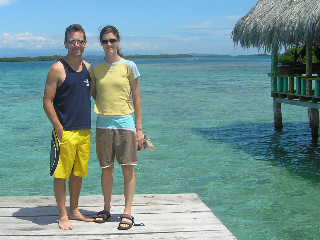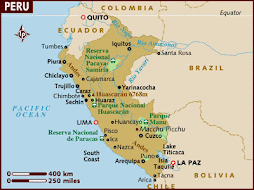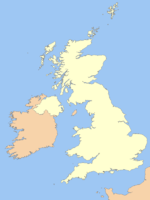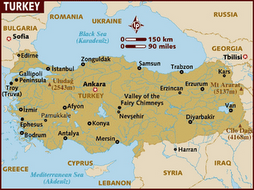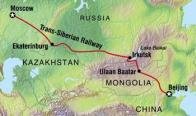Sunday, September 23, 2007
Cusco
Just a quick note to let people know I`m in Cusco, and will be heading off tomorrow on the Salkantay trek to Machu Pichu. So I´ll tell you about Cusco, Sacred valley, nearby ruins and about my trek when I get back (5 days)
Saturday, September 22, 2007
Iquitos
 Iquitos is apparently the largest city in the world not accessible by road, as its surrounded by rivers, and most notably the Amazon. Its was set up by the Spanish so it has some grand river front buildings, and it enjoyed the rubber boom, and even has a metal building by Eiffel of Eiffel tower fame! Nowdays its a hot, noisy city with mototaxis everywhere, and its own relaxed vibe.
Iquitos is apparently the largest city in the world not accessible by road, as its surrounded by rivers, and most notably the Amazon. Its was set up by the Spanish so it has some grand river front buildings, and it enjoyed the rubber boom, and even has a metal building by Eiffel of Eiffel tower fame! Nowdays its a hot, noisy city with mototaxis everywhere, and its own relaxed vibe.Leila, who I met in Lagunas and on our jungle tour is from Iquitos, and kindly
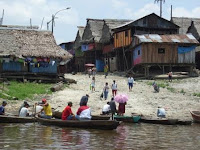 offered to let me stay with her, her
offered to let me stay with her, her  husband Hans, and their Swiss neighbours (Claudia and Freddy), at her family home. So I was treated to an insiders view of the city, and a welcoming and friendly place to stay. While Leila was busy catching up with Family, Hans was excellent tour guide, renting a boat for us to go and visit Belen, a poor ¨floating¨suburb of Iquitos.
husband Hans, and their Swiss neighbours (Claudia and Freddy), at her family home. So I was treated to an insiders view of the city, and a welcoming and friendly place to stay. While Leila was busy catching up with Family, Hans was excellent tour guide, renting a boat for us to go and visit Belen, a poor ¨floating¨suburb of Iquitos.  The river was low so most of the houses were grounded,
The river was low so most of the houses were grounded,  with some boats left on disturbing angles... But it was still certainly an eyeopener to see how the poeple live on the river... river used for washing, transport, rubbish, toilet...
with some boats left on disturbing angles... But it was still certainly an eyeopener to see how the poeple live on the river... river used for washing, transport, rubbish, toilet...Check out the bbq grubs along with the sausages and nuts... I wasnt game to try. There were also turtle eggs for sale.
From Iquitos I was sad to say goodbye to my Swiss friends, as I flew to Lima and then Cusco.
Thursday, September 20, 2007
Amazonias
 Yurimaguas
YurimaguasMy river adventure began in Yurimaguas where I was met on arrival at the collectivo stand at 10pm by a tour guide, suggesting I join a group of 4 Swiss people and visit the national parkSamira Pakaya for 3 days.... as that was where I was wanting to go, I said I´d think about it.
The next morning I went for a wander thru the town and market to get myself some breakfast, and found it to be a friendly buzzingly place, with even more moto taxis than Tarapoto! And wander just off the main square and you can see the river... big and brown and a hive of activity at the various port areas. My friendly moto-
 taxi driver from the night before picked me up, ferried me to the two port areas to check what time the boats leave, helped me buy a hammock and fruit for the journey and took me to be introduced to the swiss group and guide, and then to the Eduardo 1, the boat we were to go on.
taxi driver from the night before picked me up, ferried me to the two port areas to check what time the boats leave, helped me buy a hammock and fruit for the journey and took me to be introduced to the swiss group and guide, and then to the Eduardo 1, the boat we were to go on.Eduardo 1
There are 7 Eduardo river boats, and we got Eduardo 1, the original... A three storey riverboat with the bottom for cargo and
 the motor, the second level 2nd class hammock space (crowded)and the kitchen, and the top level tourist class with hammock area and also cabins. With my hammock hung, I wandered round chatting with my fellow travellers and watching the loading of cargo, and the hive of activity onshore. Men loading very heavy looking bags (corn?), bananas fruit and the odd chicken. Others dragging then lifting huge wooden logs from the river out and into trucks... manual labour here no machines to help out. Boats coming and going, loading and unloading, refueling. Ladies and
the motor, the second level 2nd class hammock space (crowded)and the kitchen, and the top level tourist class with hammock area and also cabins. With my hammock hung, I wandered round chatting with my fellow travellers and watching the loading of cargo, and the hive of activity onshore. Men loading very heavy looking bags (corn?), bananas fruit and the odd chicken. Others dragging then lifting huge wooden logs from the river out and into trucks... manual labour here no machines to help out. Boats coming and going, loading and unloading, refueling. Ladies and  kids trying to sell fruit, icecream, hammocks, food and everything else.
kids trying to sell fruit, icecream, hammocks, food and everything else. We left at about 1pm, and headed peacefully downstream, watching the scenery as it passed. Tourist class dinner was good, and served in our own dining room. As it got darker it got cooler, and the lights attracted large beetles and bugs. Slept for a while, but as our stop was about 2pm, we packed up our stuff ready to unload and waited. Checked out the night navigation (occasional
 spotlighting of sides to check alls ok), before getting off and mototaxi to hotel. All was pitch black as the towns power cuts out at midnight.
spotlighting of sides to check alls ok), before getting off and mototaxi to hotel. All was pitch black as the towns power cuts out at midnight. Lagunas and the Jungle trip
Next morning I woke up to find myself in a village of wooden huts with thatched roofs. We (Hans, Leila, Claudia and Freddy) had breakfast, got our intro to the National Park and tour, prepared our stuff and headed off. That was the start of 3 days of being paddled down rivers in wooden canoes, relaxing and watching out for wildlife. And a few hours of very hot humid and unfortable conditions with mozzies, as we followed our guide who macheted a path thru the jungle. And boy do the mozzies come out at dark... ended up going to bed at about 7pm as I couldnt stand being bitten alive any longer! (The buggers may be put off by repellent but find thoses patches you´ve missed, or just plain bite thru your clothes!)
National Park and tour, prepared our stuff and headed off. That was the start of 3 days of being paddled down rivers in wooden canoes, relaxing and watching out for wildlife. And a few hours of very hot humid and unfortable conditions with mozzies, as we followed our guide who macheted a path thru the jungle. And boy do the mozzies come out at dark... ended up going to bed at about 7pm as I couldnt stand being bitten alive any longer! (The buggers may be put off by repellent but find thoses patches you´ve missed, or just plain bite thru your clothes!)
Next morning I woke up to find myself in a village of wooden huts with thatched roofs. We (Hans, Leila, Claudia and Freddy) had breakfast, got our intro to the
 National Park and tour, prepared our stuff and headed off. That was the start of 3 days of being paddled down rivers in wooden canoes, relaxing and watching out for wildlife. And a few hours of very hot humid and unfortable conditions with mozzies, as we followed our guide who macheted a path thru the jungle. And boy do the mozzies come out at dark... ended up going to bed at about 7pm as I couldnt stand being bitten alive any longer! (The buggers may be put off by repellent but find thoses patches you´ve missed, or just plain bite thru your clothes!)
National Park and tour, prepared our stuff and headed off. That was the start of 3 days of being paddled down rivers in wooden canoes, relaxing and watching out for wildlife. And a few hours of very hot humid and unfortable conditions with mozzies, as we followed our guide who macheted a path thru the jungle. And boy do the mozzies come out at dark... ended up going to bed at about 7pm as I couldnt stand being bitten alive any longer! (The buggers may be put off by repellent but find thoses patches you´ve missed, or just plain bite thru your clothes!) 
We saw monkeys, a sloth, birds and a croc, and also many types of trees and flowers. We camped in mosquito nets in pretty basic conditions, and our guides paddled for us, cooked, set up camp and of course explained. We ate well with quite a bit of freshly caught fish... yum. And went for a swim braving the pirahnas and crocs - no worries!
Back to Lagunas where we hung out with the guides family in their house, waiting for news of Eduardo and when it left and hence when it would arrive. It was really an eyeopener to see the family house with multiple families living together, a well in the backgarden for water, chickens dogs

 ducks and parrots all wandering around... Had lunch in town and was pleased to be undercover when it bucketed down. Sampled jungle fruit, observed local life and went on shopping expedition to find coconuts for the boat trip.
ducks and parrots all wandering around... Had lunch in town and was pleased to be undercover when it bucketed down. Sampled jungle fruit, observed local life and went on shopping expedition to find coconuts for the boat trip. Eduardo
 Back on the boat at about 4.30am, and had the top deck to ourselves since all the peruvians had fled from the cold and earlier rain. Woke up a few hours later and found we were sharing the boat with a group of Swedes with impressively large cameras. We pulled into various towns and loaded more bananas, fruit and people... all quite interesting to watch with people and goods lined up waiting. More people joined us on the top deck making it quite crowded, we sampled kitchen food (not bad - spaghetti and chicken), had some chats with our
Back on the boat at about 4.30am, and had the top deck to ourselves since all the peruvians had fled from the cold and earlier rain. Woke up a few hours later and found we were sharing the boat with a group of Swedes with impressively large cameras. We pulled into various towns and loaded more bananas, fruit and people... all quite interesting to watch with people and goods lined up waiting. More people joined us on the top deck making it quite crowded, we sampled kitchen food (not bad - spaghetti and chicken), had some chats with our  neighbours
neighbours  and shared some watermelon, and floated further downstream. Its really quite an interesting mix of people you get on board, and certainly theres no shortage of people watching! And of course you have to duck under everyones hammocks to get past to the toilet or kitchen. Went to bed in my hammock and woke at about
and shared some watermelon, and floated further downstream. Its really quite an interesting mix of people you get on board, and certainly theres no shortage of people watching! And of course you have to duck under everyones hammocks to get past to the toilet or kitchen. Went to bed in my hammock and woke at about  5am to find half the people preparing to get off at Nauta - either a 1 hr bus ride or 8 hours more by boat. We stayed on though, passing the point where the river officially starts being called the Amazon, and arriving in Iquitos at about 2pm.
5am to find half the people preparing to get off at Nauta - either a 1 hr bus ride or 8 hours more by boat. We stayed on though, passing the point where the river officially starts being called the Amazon, and arriving in Iquitos at about 2pm.
Tarapoto
 The trip further inland from Chachapoyas required a bit of patience... First of all it required a collectivo (shared car) ride to Pedro Ruiz - about 1 and a half hours away over mainly dirt roads. Mind you it was nice valleys and mountain scenery if you can ignore the dust, and arent too squished to see out by the entire family squished in around you. Then a 5 hour wait for the first bus going in the right direction, spent mainly sitting overlooking the main street, watching the world go by literally while eating wierd but nice fruit (kind of like dragon fruit), and bread. And then a ¨5 hour¨bus ride that took 7... so I arrived in tropical tarapoto at about 10 pm, and was zoomed into town by a moto-taxi (tuk tuk).
The trip further inland from Chachapoyas required a bit of patience... First of all it required a collectivo (shared car) ride to Pedro Ruiz - about 1 and a half hours away over mainly dirt roads. Mind you it was nice valleys and mountain scenery if you can ignore the dust, and arent too squished to see out by the entire family squished in around you. Then a 5 hour wait for the first bus going in the right direction, spent mainly sitting overlooking the main street, watching the world go by literally while eating wierd but nice fruit (kind of like dragon fruit), and bread. And then a ¨5 hour¨bus ride that took 7... so I arrived in tropical tarapoto at about 10 pm, and was zoomed into town by a moto-taxi (tuk tuk). Tarapoto turned out to be a pleasant if somewhat sleepy place on the surface (and especially in the heat of the day when most shops are all shut), so I took the chance to chill a bit, catch up on washing and adjust to the heat... definitely back to shorts and t-shirts and always sweating! Other than that my main impressions of the chaotic streets filled with moto-taxis, a nice quite central plaza, the total lack of other tourists, and friendly locals and good cheap fresh food.
Tarapoto turned out to be a pleasant if somewhat sleepy place on the surface (and especially in the heat of the day when most shops are all shut), so I took the chance to chill a bit, catch up on washing and adjust to the heat... definitely back to shorts and t-shirts and always sweating! Other than that my main impressions of the chaotic streets filled with moto-taxis, a nice quite central plaza, the total lack of other tourists, and friendly locals and good cheap fresh food.The highway between Tarapoto and Yurmiaguas was being worked on, so it was shut completely during the day, forcing all buses and collectivos (how I went) to travel in the dark after 6:30pm. Ended up having a rally like ride (felt a bit ill!) up the mountains as our driver appeared hell bent on being first...followed by a torrential downpour, and being stuck next to a born again Christian!
Sunday, September 09, 2007
Kuelap... mountain fort.
.JPG) After a ¨lovely¨overnight bus that arrived in Chachapoyas at the ungodly hour of 5am, I grabbed a few hours sleep and signed up for a tour to the ruins of Kuelap. (about 3hrs away)
After a ¨lovely¨overnight bus that arrived in Chachapoyas at the ungodly hour of 5am, I grabbed a few hours sleep and signed up for a tour to the ruins of Kuelap. (about 3hrs away)On the way we passed through the town of Tingo, which was having a celebration. Their main square was decorated with sand and flower carpets (being judged in the photo), there was a band and noisy fireworks, and also a parade and soccer game we missed.
.JPG) The Kuelap ruins really are on a mountain top, on a naturally rocky outcrop with great views of all the surrounding valleys. But the Chachas built up further huge walls to create a fortress town with only 3 well protected entrances. (Theres apparently more stones used in walls here than the largest pyramid in Eqypt if you believe the guide book)
The Kuelap ruins really are on a mountain top, on a naturally rocky outcrop with great views of all the surrounding valleys. But the Chachas built up further huge walls to create a fortress town with only 3 well protected entrances. (Theres apparently more stones used in walls here than the largest pyramid in Eqypt if you believe the guide book)Anyway history wise, they were a group with a few sites in the mountain area, and were later conquered by the inca, and the site was apparently abandoned by the inca following the spanish invasion and left until it was re-discovered in 1843.
 The Chachas built these round houses with thatched roofs (unlike the incan square ones) and had some distinctive diamond stone decorations. They also used some of the walls as burial places... our guide pulled out a few stones to display a skeleton.
The Chachas built these round houses with thatched roofs (unlike the incan square ones) and had some distinctive diamond stone decorations. They also used some of the walls as burial places... our guide pulled out a few stones to display a skeleton.Over all I`d have to say I was impressed, but left a little mystified... where did they
 get their water from?(the valleys a long way down) how come the houses were so close? I also found out back at the hostel that the whole area has some kind of unique archeological remains - giant stone heads which mark tombs or are sarcophagi, mummies... and more. But I`ve headed off inland again... heading towards the Iquitos and the Amazon which is at least a few days bus ride then boat ride away.
get their water from?(the valleys a long way down) how come the houses were so close? I also found out back at the hostel that the whole area has some kind of unique archeological remains - giant stone heads which mark tombs or are sarcophagi, mummies... and more. But I`ve headed off inland again... heading towards the Iquitos and the Amazon which is at least a few days bus ride then boat ride away.
Chiclayo... ruins and gold.
.JPG) Three hours further up the coast and another group of eroded mud pyramids to see... ho hum you say? Well you wouldn´t if you saw the treasure they´ve pulled out of some of these... absolutely astounding. And the size of the mud complexes such as Tucume with over 22 pyramids is also quite a sight, although rather arid, eroded and unfortunately a lot of it is closed from public access while they are working on it.
Three hours further up the coast and another group of eroded mud pyramids to see... ho hum you say? Well you wouldn´t if you saw the treasure they´ve pulled out of some of these... absolutely astounding. And the size of the mud complexes such as Tucume with over 22 pyramids is also quite a sight, although rather arid, eroded and unfortunately a lot of it is closed from public access while they are working on it.At Sipan they discovered 12 royal moche tombs in 1987 filled with
.JPG) offerings... archeologically its been compared with the discovery of Tutenkamen (however you spell that!), and it definitely hit world headlines. There is an awesome museum housing all the treasure, and showing photos step by step as they uncovered layers of ceremonial jewellery, garments and decorations that covered the bodies. Stunning goldwork earings, necklaces and other items, huge beaded collars covering their chest and shoulders and even remains of some cloth and feathers. Unfortuneately no photos allowed so you`ll just have to go visit for yourself! We (me, Grant and Deb) also visited the site itself (about an hour from town) which they`re still working on as can be seen... scraping and gently pulling pottery from the wall when we were there.
offerings... archeologically its been compared with the discovery of Tutenkamen (however you spell that!), and it definitely hit world headlines. There is an awesome museum housing all the treasure, and showing photos step by step as they uncovered layers of ceremonial jewellery, garments and decorations that covered the bodies. Stunning goldwork earings, necklaces and other items, huge beaded collars covering their chest and shoulders and even remains of some cloth and feathers. Unfortuneately no photos allowed so you`ll just have to go visit for yourself! We (me, Grant and Deb) also visited the site itself (about an hour from town) which they`re still working on as can be seen... scraping and gently pulling pottery from the wall when we were there..JPG) We made it to one other museum housing more gold and pottery from the ruins from nearby cultures... This gold mask is from Chimu ruins if I remember rightly.
We made it to one other museum housing more gold and pottery from the ruins from nearby cultures... This gold mask is from Chimu ruins if I remember rightly.And Chiclayo was where I said goodbye to the other Aussies and caught a night bus inland.
Trujillo- impressive mud ruins
.JPG) After the Mountains I caught a slightly hair-raising bus through the Canon del Pato down to the coast and the town of Trujillo. (Don´t like the bus rocking from side to side thru potholes when you have a 100m drop down to the river...) But the canyon was spectacular... a bumpy dirt road carved into the mountainside following a river down, with quite a few tunnels cut thru as well. The photo taken out of the window doesn´t do it justice at all, but hopefully gives some idea of the rockiness of countyside.
After the Mountains I caught a slightly hair-raising bus through the Canon del Pato down to the coast and the town of Trujillo. (Don´t like the bus rocking from side to side thru potholes when you have a 100m drop down to the river...) But the canyon was spectacular... a bumpy dirt road carved into the mountainside following a river down, with quite a few tunnels cut thru as well. The photo taken out of the window doesn´t do it justice at all, but hopefully gives some idea of the rockiness of countyside.Trujillo is on the coast, and actually has a quite pleasant colonial centre. But I came to see the ruins nearby... the giant adobe pyramids of the sun and moon, and a whole city/ royal complex known as Chan Chan. The whole area is really sandy and desolate, but
.JPG) with the irrigation pioneered by these ancient people its made fertile to grow sugar cane, asparagus and other crops. I took a tour of the main ruins with Michael, an Englishman running the hostel I stayed at. And I met up with Grant and Deb - an Aussie couple from Cairns who I travelled with for the next few days.
with the irrigation pioneered by these ancient people its made fertile to grow sugar cane, asparagus and other crops. I took a tour of the main ruins with Michael, an Englishman running the hostel I stayed at. And I met up with Grant and Deb - an Aussie couple from Cairns who I travelled with for the next few days.The pyramids are rather big, but still dwarfed by the rocky and apparanently sacred mountain nearby. They´re quite eroded, and at first glance disappointing with the rest of the buildings between
.JPG) the pyramids covered mainly by sand. But get closer to where they´ve excavated in the 90s and you find huge walls decorated with mud shaped and colourful painted people, creatures and symbols... absolutely incredible considering their age.. first 6 centuries AD. The Moche people who built it didn´t leave writing, and whats know is know thru their pottery and now these friezes... it appears the pyramid was a large religious and sacraficial centre. And don´t you just wonder whats under the rest of that sand and adobe brick!
the pyramids covered mainly by sand. But get closer to where they´ve excavated in the 90s and you find huge walls decorated with mud shaped and colourful painted people, creatures and symbols... absolutely incredible considering their age.. first 6 centuries AD. The Moche people who built it didn´t leave writing, and whats know is know thru their pottery and now these friezes... it appears the pyramid was a large religious and sacraficial centre. And don´t you just wonder whats under the rest of that sand and adobe brick!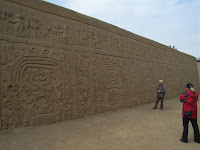.JPG)
We also visited another Huaca (Arco Iris) which was puzzling... wierd pyrimidal structure with perhaps store rooms only accessable from the top?? Anyway impresive mud decorated walls even if you can´t quite fathom the purpose.
And then on to Chan Chan... the huge city and royal palace of its day, which is now mile of desert with mounds showing where walls and buildings stood and the main highway heading straight through the middle of it. Only one royal complex is open and restored/excavated, but its really
.JPG) different again and interesting with large courtyards, wells and ¨cross¨decorations all over the place, not to forget the squirrel/bird creature either... This site is from another group again.. the Chimu (known for their fine gold work), they were later than the Moche, and surrendered to the Incas in 1471 apparently after years of seige and threats to cut water supplies.
different again and interesting with large courtyards, wells and ¨cross¨decorations all over the place, not to forget the squirrel/bird creature either... This site is from another group again.. the Chimu (known for their fine gold work), they were later than the Moche, and surrendered to the Incas in 1471 apparently after years of seige and threats to cut water supplies.And lastly nearby Trujillo is the coastal town of Haunaco which is known for its
.JPG) reed fishing
reed fishing .JPG) boats/surfing boats!
boats/surfing boats!
Sunday, September 02, 2007
Cordilleras Blancas... Big Peruvian Mountains!
 I caught a bus from Lima to Huaraz, which wound along the coast thru huge sandunes and then up through the mountains...and discovered off putting sensations associated with high altitudes... headaches, and slight disorientation kind of like your drunk. Here I met up with Miles from London, and for the last few days we´ve been travelling together.
I caught a bus from Lima to Huaraz, which wound along the coast thru huge sandunes and then up through the mountains...and discovered off putting sensations associated with high altitudes... headaches, and slight disorientation kind of like your drunk. Here I met up with Miles from London, and for the last few days we´ve been travelling together.We visited Chavin, ruins from about 1000BC, so definitely pre-inca. They were in another valley so we caught a local chicken bus (it had chickens loaded on top  along with fuzbol tables, little chicks inside), which took forever winding up thru the mountains to this tunnel pass at 4500m inducing altitude sickness in many of the passengers, before dropping back down into the valley. The ruins kind of reminded me of Mexican ruins... stones, sunken central square plazas, carved rock heads... but these are really old. What was unique was the labrinth of rooms and passages inside/underground which you could explore... no one quite knows what these were for but they were huge...and had these cool airvents to let air flow around.
along with fuzbol tables, little chicks inside), which took forever winding up thru the mountains to this tunnel pass at 4500m inducing altitude sickness in many of the passengers, before dropping back down into the valley. The ruins kind of reminded me of Mexican ruins... stones, sunken central square plazas, carved rock heads... but these are really old. What was unique was the labrinth of rooms and passages inside/underground which you could explore... no one quite knows what these were for but they were huge...and had these cool airvents to let air flow around.
 along with fuzbol tables, little chicks inside), which took forever winding up thru the mountains to this tunnel pass at 4500m inducing altitude sickness in many of the passengers, before dropping back down into the valley. The ruins kind of reminded me of Mexican ruins... stones, sunken central square plazas, carved rock heads... but these are really old. What was unique was the labrinth of rooms and passages inside/underground which you could explore... no one quite knows what these were for but they were huge...and had these cool airvents to let air flow around.
along with fuzbol tables, little chicks inside), which took forever winding up thru the mountains to this tunnel pass at 4500m inducing altitude sickness in many of the passengers, before dropping back down into the valley. The ruins kind of reminded me of Mexican ruins... stones, sunken central square plazas, carved rock heads... but these are really old. What was unique was the labrinth of rooms and passages inside/underground which you could explore... no one quite knows what these were for but they were huge...and had these cool airvents to let air flow around. We moved to Karaz, as Huaraz is a bit hectic and Karaz is a more laidback  sleepy place, but with good access to walks. So we took a tour up to visit the mountains opposite the main range - so fantastic views of the snowcapped mountain ranges. And they are high... most of the big peaks are 6000m or more. And today we headed up to some lakes and did a fairly exhausting walk up to another lake and glacier... going up hill at any altitude really gets you puffing. And at the top (about 4300m) we felt so odd we pretty much had a quick look, took photos and legged it down to a more reasonable height to have some lunch. It was an absolutely spectacular walk up the valley between all these snow topped mountains... photos don´t do it any justice.
sleepy place, but with good access to walks. So we took a tour up to visit the mountains opposite the main range - so fantastic views of the snowcapped mountain ranges. And they are high... most of the big peaks are 6000m or more. And today we headed up to some lakes and did a fairly exhausting walk up to another lake and glacier... going up hill at any altitude really gets you puffing. And at the top (about 4300m) we felt so odd we pretty much had a quick look, took photos and legged it down to a more reasonable height to have some lunch. It was an absolutely spectacular walk up the valley between all these snow topped mountains... photos don´t do it any justice. 
 sleepy place, but with good access to walks. So we took a tour up to visit the mountains opposite the main range - so fantastic views of the snowcapped mountain ranges. And they are high... most of the big peaks are 6000m or more. And today we headed up to some lakes and did a fairly exhausting walk up to another lake and glacier... going up hill at any altitude really gets you puffing. And at the top (about 4300m) we felt so odd we pretty much had a quick look, took photos and legged it down to a more reasonable height to have some lunch. It was an absolutely spectacular walk up the valley between all these snow topped mountains... photos don´t do it any justice.
sleepy place, but with good access to walks. So we took a tour up to visit the mountains opposite the main range - so fantastic views of the snowcapped mountain ranges. And they are high... most of the big peaks are 6000m or more. And today we headed up to some lakes and did a fairly exhausting walk up to another lake and glacier... going up hill at any altitude really gets you puffing. And at the top (about 4300m) we felt so odd we pretty much had a quick look, took photos and legged it down to a more reasonable height to have some lunch. It was an absolutely spectacular walk up the valley between all these snow topped mountains... photos don´t do it any justice. 
Subscribe to:
Posts (Atom)
